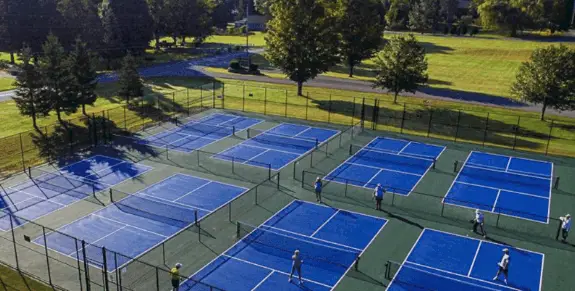Pickleball is a sport that is being incorporated more and more into schools, clubs and recreation centres. There are also people who build their own Pickleball courts at home, provided they have the space. Because Pickleball does not take up nearly as much space as tennis, and because it is a sport that is more accessible to all kinds of players, all ages and abilities, it is growing in popularity.
So what do you need to build your own Pickleball court?
Well, if you are building at a school, club or recreation centre, and you have the budget, you should probably call in the professionals and let them do it for you. But if you are building your own backyard Pickleball court, you can build your own.
You can build a Pickleball court over tennis courts. You can build them on clay and the good news is that at a recreational level, you can build them and play on grass as well, which might work out best for your backyard Pickleball court.
Here are our guidelines on how to build a backyard pickleball court.
Table of Content
1. Space
You need space to build a Pickleball court. One can fit four Pickleball courts into a tennis court, so that will give you an idea of the space you need.
If you are building a Pickleball court for yourself at home, you only need one court. But if you are building a Pickleball court for a school, club or recreation centre, you probably want at least two.
A Pickleball court is 20 x 44 feet, so you need this amount of space, plus a little space around it for ease of entry.
If you already have a tennis court, you are all set to go. But if you don’t, you need to look at your grass or yard space, and determine that you have enough for a Pickleball court.
You should try and orient your Pickleball court so that is north-south. You want to try and take into account the position of the sun and where shadows will be cast during the day.
Mostly, a court should be positioned north-south, but of course it depends on what other structures you have around you. If you are unsure, keep an eye on the space for a few days, noting the shadows, before you orient the court.
Some people are such passionate Pickleball players that they are willing to devote their entire yard or garden to game. If you are only going to play once a year, it’s not a good idea to build your own court. But if you are playing regularly, determine the space you have, and let’s start building!
Also Read:
2. Surface
Remember you have multiple options here:
- On a tennis court
- Grass
- Concrete
We are going by the assumption you don’t have a clay surface lying around or you don’t want to spend too much more than needed either, so we will keep that out of this discussion.
On a Tennis Court
Building on a tennis court is the easiest as you already have the structure in place, but there it can sometimes take a bit of practice to get used to the lines of a tennis court and a Pickleball court. Saying that, most clubs use tennis courts for Pickleball.
On Grass
Grass is the next easiest option for you at home, if you have a grass space. You will want to mow your grass initially and keep it as smooth and even as possible.
If you play a lot of Pickleball, this will happen automatically through wear and tear. You will need to mow the grass from time to time, and keep it as even, and low, as possible.
On Concrete
Concrete is the best type of surface as once you have the concrete in place, there is no upkeep at all. Concrete is always the preferred surface for a Pickleball court, much like it is for a tennis court.
You might have a concrete space already which would be perfect. If not, throwing a big slab is not too costly, but again, you need to be committed to your Pickleball game!
There are two more options but we are not going to go into detail as they are not ideal. Asphalt or tar is an inexpensive option. You might have driveway space that you could use. And you can get snap together plastic that you snap over all of the above, but this is a different scheme altogether.
3. Fencing
Pickleball courts need a perimeter fence. Without a perimeter fence the players will need to keep collecting the ball, which is pretty horrible and nobody wants to do this. If you are doing a backyard Pickleball court, you can put in your own fencing.
If you can afford to use a contractor, let them do the fencing so that it is professional, and of course, easy for you.
You can use any kind of fencing you want but if you are using wire, make sure it is rust proof so you don’t have any injuries if your into the fence.
Wire also makes sense so you can chat to people who are watching or just hanging out on the other side of the court, waiting for their chance to play. Wire also makes sense for a Pickleball coach, so he or she can chat to their players through the fence.
The fence dimensions:
- A wire fence should be approximately 10 feet high.
- You can go lower if cost is an issue.
- You can do part fence and part padding or cladding above the fence.
- The fence will run along all sides of the court, with an entrance or doorway.
Also Read:
4. Pickleball Lines and Markers
If you have a contractor they will install the Pickleball lines and markers for you, professionally and so that you do not have to remove them or redo them for many years.
Your contractor will know exactly what to do and where to put the lines, following the guidelines for the USA Pickleball Association.
If you are doing them on your own:
- The lines of the Pickleball court should be white, or clear to see against your surface.
- Lines must be 2 inches wide.
If you are doing a makeshift court, use thick sidewalk chalk, but note this will rub out fairly quickly.
You can also use 2 inch wide tape, in a color that is different to your surface. Masking tape works too.
If you are painting on concrete or asphalt, use a standard Contractor’s paint, a chalk based paint, an acrylic paint or an exterior PVFA.
If your lines are on grass, use a Pickleball set that you stake into the ground, with stake and tape. Of course you can custom design your own too.
The Baselines
Your baselines will run parallel to the Pickleball net, which we will discuss below. There is a baseline on either side of the net (there are two sides to a Pickleball court) and they run the size of the net.
The Sidelines
These run all along the court, perpendicular to the net, joining the baseline.
The Non Volley Lines
These are on both sides of the Pickleball net, and are 7 feet away from the net, between the sidelines, running parallel to the Pickleball net.
The Centre Lines
These lines are on either side of the Pickleball net and they run between the baseline, sidelines and the non-volley lines.
The Non Volley Zone
This will have been marked out by the above lines, but the non volley zone is the area of the Pickleball court that is in front of the net, on either side, surrounded by the sidelines and the non volley line.
The Service Court
This too will have been marked out by the lines, but the service court, which are on either side of the centre lines, and on both sides of the court, are surrounded by the baselines, sidelines and volley lines.
5. The Pickleball Net
You can put the net in before or after you have painted or chalked or taped the court lines. As long as it is dead centre you are fine.
Pickleball nets can be bought in Pickleball sets. You can make your own as well, if you are doing a makeshift Pickleball court. And if you have a contractor, they will supply the proper and professional Pickleball net.
The dimensions of the net
The length of the net is 21 feet and 9 inches long, and will extend from one net post to the other.
The height of the net changes from the edges to the middle. The middle of the Pickleball next is 34 inches and the sidelines are 36 inches. The tautness and change in height will come when you put in the net, tie it to the two posts and adjust it.
The posts for the net
You need two posts and two sleeves that will go into the ground to hold the posts. If you have a contractor, he will do this professionally for you. If you are making the posts on your own, each one should be 50 inches long and you can use any material that will stand in the ground and hold the weight of your net.
The one thing you should spend money on for your Pickleball court is the net and posts. It is so easy to order online, or to buy, and the bought nets come with all the equipment you need for assembly, and will last for many years if you look after them.
6. Playing at night?
Add some lighting to your pickleball court (and here’s our in-depth guide on pickleball court lighting).
You can add a light pole on each side of the Pickleball court, in the centre and right at the back.
Use poles of between 18 and 20 feet high, keep them about 20 inches (minimum) from the back of the court (this is why you need a bigger outer fence) and mount 1.500 watt lights in them. Lighting is great for night, but also for those grey winter days.
7. Ready for a game?
All you need to do now is get your footwear on, pick up a paddle, get the ball, shake hands before the game and get going! Pickleball is such fun, sociable, great exercise, skillful and competitive too.
As we always say, have fun while playing this glorious game of pickleball.


